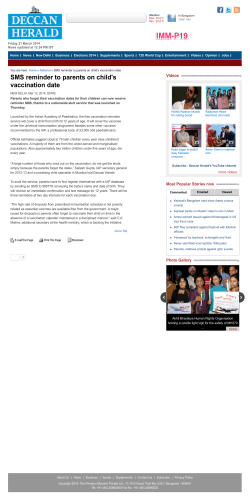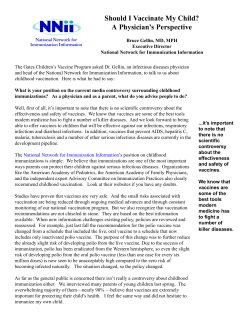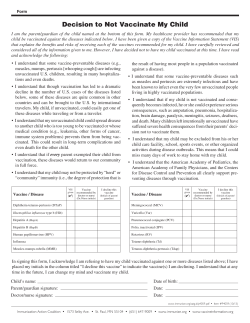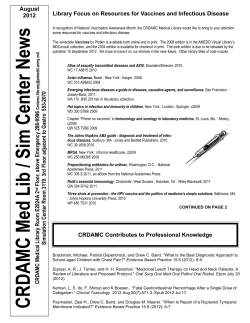
Call to Action Improving Vaccination Rates in Pregnant Women:
Call to Action Improving Vaccination Rates in Pregnant Women: Timely intervention – lasting benefits A report by the National Foundation for Infectious Diseases (NFID) in partnership with the American College of Obstetricians and Gynecologists (ACOG), the American Academy of Pediatrics (AAP), and the Centers for Disease Control and Prevention (CDC) March 2014 Call to Action Improving Vaccination Rates in Pregnant Women: Timely intervention – lasting benefits Vaccination in pregnant “ women is a two-for-one healthcare intervention because it protects expectant mothers and improves the chances of a healthy delivery while providing essential protection for babies during the first few months of life… ” This document reflects discussions and conclusions of a group of experts convened by the National Foundation for Infectious Diseases (NFID) to focus on educating pregnant women and women planning to become pregnant about the benefit of vaccines and improving vaccination rates. This program was developed and implemented by NFID in partnership with the American College of Obstetricians and Gynecologists (ACOG), the American Academy of Pediatrics (AAP), and the Centers for Disease Control and Prevention (CDC). Page 5 includes a complete list of supporting organizations. Made possible by unrestricted educational grants from Merck & Co., Inc., Novartis Vaccines, and GlaxoSmithKline. NFID’s policies prohibit funders from controlling program content. March 2014 1 Vaccines have had an enormous health impact in the US and across the globe Influenza vaccine is not the only one recommended for pregnant women. The Centers for Disease Control and Prevention, the American College of Obstetricians and Gynecologists, and the American College of Nurse-Midwives currently recommend that women get a dose of Tdap (tetanus, diphtheria, acellular pertussis) vaccine between weeks 27 and 36 of each pregnancy in order to protect them and their newborns from pertussis, or whooping cough.11,12 Newborns, who are at the highest risk of severe illness and death from whooping cough, cannot begin their vaccination series until two months of age and are not fully protected until after their third dose of a pertussis-containing vaccine.13,14 However, the pregnant woman’s antibodies to pertussis can cross the placenta and protect her infant from pertussis infection. The protective antibodies that babies get from their mothers can be life-saving: half of infants who develop pertussis will be hospitalized and one to two of every 100 infants hospitalized with pertussis will die.13 Vaccination has prevented more than 100 million cases of serious disease in the US1 and is recognized as one of the top public health achievements of all time.2 It has led to the eradication of smallpox worldwide. In the US, vaccination programs have eliminated polio, rubella, and measles (although measles outbreaks associated with imported cases continue to occur)3, and greatly limited cases of deadly diseases, such as tetanus, pneumonia, and many others. In the past decade, hospitalizations, deaths, and healthcare costs associated with vaccine-preventable diseases have continued to decline, largely related to the use of new vaccines (rotavirus, quadrivalent meningococcal conjugate, herpes zoster, pneumococcal conjugate, and human papillomavirus).4 Despite this success, US vaccination rates remain suboptimal and below the Healthy People 2020 public health goals. In general, current US vaccination rates are inversely related to age, with the highest rates in infants and toddlers, lower rates in adolescents, and the lowest rates in adults.5 While the differences between current vaccination rates and public health goals vary, there is room for improvement across all ages.5 There is no evidence of risk to the mother or developing baby from any inactivated vaccine.15,16 The benefits of vaccinating pregnant women usually outweigh potential risks when the likelihood of disease exposure is high, when infection would pose a risk to the mother or developing baby, and when the vaccine is unlikely to cause harm. Live virus vaccines, however, pose a theoretical risk to the developing baby and should not be given during pregnancy.17 A complete list of recommended vaccines before, during, and after pregnancy is available at: www.cdc.gov/vaccines/pubs/downloads/f_preg_chart.pdf. It is important to note that, while the flu “shot” is an inactivated (killed) vaccine and can be given to pregnant women at any time during their pregnancy, the nasal spray flu vaccine is a live vaccine that should not be administered to this population. Improving vaccination rates in pregnant women will improve health outcomes in several ways One key strategy to increase vaccination rates is to focus vaccination efforts in pregnant women. Vaccination is a two-forone healthcare intervention in this group because it protects expectant mothers and improves the chances of a healthy delivery while providing essential protection for babies during the first few months of life when they are too young to respond to vaccinations and be fully protected. Vaccination also has the potential to protect other members of the household. Influenza (flu) vaccination is important for pregnant women because they are at increased risk of severe illness and death due to flu compared with the general population,6 an outcome that was evident during the 2009 influenza pandemic.7 Pregnant women who became sick enough from 2009 H1N1 influenza to require intensive care had approximately a 20 percent risk of dying, and the risk of low-birth weight infants was increased among those who delivered during their hospitalization for influenza-related illness.8 Vaccinating the mother during pregnancy also helps to prevent influenza-related hospitalization in her baby during the first six months of life.9,10 2 Pregnancy is an opportune time to reach expectant parents with positive health messages vaccination, with pregnant women. HCPs need to recognize and capitalize on the value of these discussions throughout pregnancy and into the postpartum period. The American College of Obstetricians and Gynecologists Immunization Expert Work Group and Committees on Gynecologic and Obstetric Practice call on obstetricians to “talk with the patient directly and recommend indicated vaccines.”24 This direct communication matters because patient surveys show that HCPs have a major influence on a patient’s ultimate decision about whether to receive vaccines for themselves and their children.25-27 Pregnant women and women planning to become pregnant are generally motivated to improve their own health with the goal of delivering a healthy baby. During pre-pregnancy planning and throughout pregnancy, women tend to follow a healthier lifestyle, such as reducing or eliminating alcohol consumption, quitting smoking, improving eating habits, and increasing folic acid intake. 18-21 Pregnant women also have shown a willingness to get vaccinated. As women and their obstetrical providers recognized the threat of influenza, vaccination rates increased from below 20 percent to almost 50 percent in pregnant women during the 2009-2010 flu season.22 This rate has been maintained and has increased to over 50 percent through the most recent influenza seasons, but there is still a long way to go to bring protection to all pregnant women and their babies. The tone of the vaccine discussions between obstetrical care providers and patients is important. A recent study examined the effect of how an HCP initiated the vaccine discussion on the parent’s vaccination decisions for their children.28 Stronger HCP recommendations led to parents being more likely to accept the vaccines without challenge. Alternately, less compelling language from the HCP was more likely to be met with vaccine hesitance. However, when HCPs persisted, nearly half of hesitant parents chose to vaccinate. Pregnancy and pregnancy planning are opportune times to deliver health messages because women have frequent contact with healthcare professionals (HCPs) in this context. Developed jointly by AAP and ACOG, Guidelines for Perinatal Care calls for about 14 visits throughout pregnancy.23 Each visit is a chance for an HCP to discuss good health habits, including Another reason to focus on delivering vaccine messages during pregnancy and the postpartum period is that it can lay a positive foundation for the vaccine series recommended for the infant.29 More than 8 in 10 pediatric HCPs will face parental refusal of one or more vaccines every year.30 Instilling positive vaccine messages in expectant and new mothers may help ease the transition from obstetrical to pediatric care and the acceptance of essential vaccines that follow. Instilling these positive messages also can help establish new mothers/parents as long-term vaccine advocates across the entire family from infancy, to childhood and adolescence, and into adulthood. All HCPs and expecting or new mothers/parents should review available information and: nL earn about vaccines available to prevent Recognizing the changing landscape of vaccine decision making various diseases nU nderstand the recommended Vaccine skepticism is not new—Benjamin Franklin was a skeptic who chose not to vaccinate his 4-year-old son against smallpox, a decision he later regretted when his son died of the disease.31,32 But today, the Internet and 24-hour news cycle put more information into the hands of consumers than ever before and many have noted that the media may report on “dangers” of vaccines regardless of scientific validity. 30,33 Against a backdrop of very low disease incidence in the United States, based on widespread immunization, the value of vaccines is less obvious and the less common minor risks from the intervention become the focus. However, it is clear that, without continued vaccination efforts and high levels of vaccine coverage, vaccine-preventable diseases could again become highly prevalent in a short time. immunization schedule for all family members n ( HCPs) Vaccinate expecting or new mothers/ parents as recommended n ( Expecting/new mothers) Receive all recommended vaccines nA dvise other expecting or new mothers/ parents about the importance of recommended vaccines for themselves and their families Slovic and Fischhoff, in their work as cognitive psychologists, have described the innate human behavior that makes it 3 challenging for individuals to conceptualize and measure risk versus benefit when the risk is not clearly evident, as is true today with low incidence of vaccine-preventable diseases.34-36 The subconscious feels the benefit of vaccines is small—“I don’t see measles or whooping cough around me,” and then the fear of potential side effects intensifies. Even if direct vaccination services are not within the scope of the practice, every HCP should learn about vaccines and the recommended immunization schedule for pregnant women, as well as local immunization resources so they can effectively counsel and refer their patients. The recommended US immunization schedule is based on the best science available.38,39 The schedule is reviewed at least annually, and formulated and adopted after in-depth review of data, extensive discussion, and a vote by a panel of independent experts who are supported by professionals at CDC and other organizations. While the US immunization program is one of the greatest public health successes in history, individuals and groups may launch attacks against the program that lack scientific merit but play on fears.30,33 Patients are more likely than ever to question a variety of things: vaccine safety and efficacy, the need to follow the recommended schedule, the number of shots per visit, and their impact on immune system, etc.30 HCPs need to develop tools to respond efficiently and effectively to questions from concerned patients and parents. A major consideration in the vaccination schedule is timing: providing immunity before exposure to vaccine-preventable diseases.38 A critical time is before or during pregnancy. Delaying scheduled vaccines leaves women and their babies unprotected at a time when they may be most vulnerable to several infectious diseases. HCPs play a pivotal role in maintaining benefits of the US immunization program. One way to make sure that individuals and society are protected is by supporting a continuum of immunity that starts even before a baby is born—in the pregnant woman. It is critical to educate parents-to-be that the vaccination schedules for children, adolescents, and adults consider practical issues, including vaccine timing, spacing, and delivery, to maximize protection against serious infectious diseases. Parents who recognize the importance of the immunization schedule and understand challenges in delivery (e.g., how often a child is seen by a provider) will be more likely to follow the CDC recommended schedules for their child from infancy through adulthood. HCPs who are counseling pregnant women and those planning to become pregnant should also begin to proactively address the safety concerns that may prevent parents from compliance with the Call to Action: Healthcare professionals need to take action to improve vaccination rates All HCPs who have contact with pregnant women, women planning to become pregnant, or new parents can play a role in delivering positive vaccine messages. As trusted advisors, they need to be prepared to address women’s concerns and reinforce the well-documented safety and efficacy of vaccination. HCPs can reinforce to their patients that influenza vaccination has been recommended during pregnancy for nearly half a century.6 Furthermore, they can provide reassurance about influenza vaccine safety in any trimester, as it has been given to millions of pregnant women and has not been shown to cause harm to them or their babies.37 Those who provide direct obstetrical care should consider how to start or expand vaccination services in their practices. In public health departments, this may mean finding ways to integrate vaccination into prenatal care coordination. The combination of an HCP recommendation and an offer of vaccine yields the highest immunization rates. During the most recent influenza season, vaccine coverage was 70 percent for women who got both an HCP recommendation and an offer for vaccination, but only 46 percent for those who got only the recommendation, and 16 percent for women who got neither.22 4 References vaccine schedule for their children. Evidence-based safety information should be clearly communicated, as should the potential consequences of non-compliance.30 Whether considering vaccines for a pregnant woman, her newborn, or for any other family member, the HCP needs to clearly communicate that the vaccine schedule should be followed to maximize immunity and minimize the burden and impact of vaccine-preventable diseases. Resources available from public health and professional organizations NFID and its program partners have developed a variety of educational resources about vaccines and their appropriate use. The Family Vaccines Resource Center will be available April 2014 at www.family-vaccines.org. It will serve as a centralized online portal to easily locate specific resources based on individual interests and needs. The resources included are all free and available for the benefit of HCPs and expecting or new mothers/parents. 1. Van Panhuis WG, Grefenstette J, Jung SY, et al. Contagious diseases in the United States from 1888 to the present. N Engl J Med. 2013;369:2152-8. 2. Centers for Disease Control and Prevention (CDC). Top great public health achievements—United States, 1900-1999. MMWR Morb Mortal Wkly Rep. 1999;48(12):241-3. 3. Centers for Disease Control and Prevention (CDC). Measles — United States, January 1–August 24, 2013. MMWR Morb Mortal Wkly Rep. 2013; 62(36):741-743. 4. Centers for Disease Control and Prevention (CDC). Top great public health achievements—United States, 2001-2010. MMWR Morb Mortal Wkly Rep. 2011;60(19):619-23. 5. US Department of Health and Human Services (US DHHS). Office of Disease Prevention and Health Promotion. Healthy People 2020. Washington, DC. Available at http://www.healthypeople.gov/2020/data/searchData.aspx. Accessed November 29, 2013. 6. Beigi RH. Influenza during pregnancy: a cause of serious infection in obstetrics. Clin Obstet Gynecol. 2012;55(4):914-26. 7. Kelly H, Peck HA, Laurie KL, Wu P, Nishiura H, Cowling BJ. The age-specific cumulative incidence of infection with pandemic influenza H1N1 was similar in various countries prior to vaccination. PLOS One. 2011;6(8). Epub August 5, 2011. 8. Centers for Disease Control and Prevention (CDC). Maternal and infant outcomes among severely ill pregnant and postpartum women with 2009 pandemic influenza A (H1N1) – United States, April 2009 – August 2010. MMWR Morb Mortal Wkly Rep. 2011;60(35):1193-6. 9. Poehling KA, Szilagyi PG, Staat MA, Snively BM, Payne DC, Bridges CB, Chu SY, Light LS, Prill MM, Finelli L, Griffin MR, Edwards KM, for the New Vaccine Surveillance Network. Impact of maternal immunization on influenza hospitalizations in infants. American Journal of Obstetrics & Gynecology. 2011;June:S141-S148. Supporting Organizations n American Academy of Family Physicians n American Academy of Pediatrics n American Academy of Physician Assistants n American College of Nurse-Midwives n American College of Obstetricians and Gynecologists n American Nurses Association n American Pharmacists Association 10. Benowitz I, Esposito DB, Gracey KD, Shapiro ED, Vázquez M. Influenza vaccine given to pregnant women reduces hospitalization due to influenza in their infants. Clin Infect Dis. 2010;51(12):1355-61. n Association of State and Territorial Health Officials n Association of Women’s Health, Obstetric and Neonatal Nurses 11. ACIP Adult Immunization Work Group, Bridges CB, Woods L, Coyne-Beasley T, CDC. Advisory Committee on Immunization Practices (ACIP) recommended immunization schedule for adults aged 19 years and older—United States, 2013. MMWR Surveill Summ. 2013;62(Suppl 1):9-19. n Centers for Disease Control and Prevention n Every Child By Two n Families Fighting Flu n Immunization Action Coalition 12. American College of Obstetricians and Gynecologists (ACOG). ACOG committee opinion no. 566: update on immunization and pregnancy: tetanus, diphtheria, and pertussis vaccination. Obstet Gynecol. 2013;121:1411-4. n March of Dimes n National Association of County and City Health Officials 13. Centers for Disease Control and Prevention (CDC). Pertussis Frequently Asked Questions. Available at: http://www.cdc.gov/pertussis/about/faqs.html. Accessed November 29, 2013. n National Association of Pediatric Nurse Practitioners n National Foundation for Infectious Diseases 14. Mattoo S, Cherry JD. Molecular pathogenesis, epidemiology, and clinical manifestations of respiratory infections due to Bordetella pertussis and other Bordetella subspecies. Clin Microbiol Rev. 2005;18(2):326-82. n National Healthy Mothers, Healthy Babies Coalition n National Vaccine Program Office 5 15. Louik C, Ahrens K, Kerr S, Junhee P, Chambers C, Jones KL, Schatz M, Mitchell AA. Risks and safety of pandemic H1N1 influenza vaccine in pregnancy: exposure prevalence, preterm delivery, and specific birth defects. Vaccine. 2013;31:5033-5040. 28. Opel DJ, Heritage J, Taylor JA, et al. The architecture of providerparent vaccine discussions at health supervision visits. Pediatrics. 2013;132(6):2013-37. 29. Frew PM, Zhang S, Saint-Victor DS, et al. Influenza vaccination acceptance among diverse pregnant women and its impact on infant immunization. Hum Vaccin Immunother. 2013;9(12): [Epub ahead of print]. 16. Chambers CD, Johnson D, Xu R, Luo Y, Louik C, Mitchell AA, Schatz M, Jones KL, the OTIS Collaborative Research Group. Risks and safety of pandemic h1n1 influenza vaccine in pregnancy: birth defects, spontaneous abortion, preterm delivery, and small of gestational age infants. Vaccine. 2013;31:5026-5032. 30. Healy CM, Pickering LK. How to communicate with vaccine-hesitant parents. Pediatrics. 2011;127:S127-33. 17. Centers for Disease Control and Prevention (CDC). Guidelines for vaccinating pregnant women. Available at: http://www.cdc.gov/vaccines/pubs/preg-guide.htm. Accessed December 4, 2013. 31. Franklin B. The Autobiography of Benjamin Franklin. Hazleton, PA: Pennsylvania State University; 2012. 32. Best M, Katamba A, Neuhauser D. Making the right decision: Benjamin Franklin’s son dies of smallpox in 1736. Qual Saf Health Care. 2007;16(6):478-80. 18. Backhausen MG, Ekstrand M, Tydén T, et al. Pregnancy planning and lifestyle prior to conception and during pregnancy among Danish women. Eur J Contracept Reprod Health Care. 2013; November 15. [Epub ahead of print.] 33. Ahearn B. The autism-vaccines myth: the impact of the media. Psychology Today. Available at: http://www.psychologytoday.com/blog/radical-behaviorist/201002/ the-autism-vaccines-myth-the-impact-the-media. Accessed December 4, 2013. 19. Curry SJ, McBride C, Grothaus L, Lando H, Pirie P. Motivation for smoking cessation among pregnant women. Psychol Addict Behav. 2001;15(2):126-32. 20. Dupraz J, Graff V, Barasche J, Etter JF, Boulvain M. Tobacco and alcohol during pregnancy: prevalence and determinants in Geneva in 2008. Swiss Med Wkly. 2013;May 25;143:w13795. 34. Ropeik D. Inside the mind of worry. New York Times. September 28, 2012. Available at: http://www.nytimes.com/2012/09/30/opinion/sunday/why-smartbrains-make-dumb-decisions-about-danger.html?_r=2&. Accessed December 9, 2013. 21. Tong VT, Dietz PM, Farr SL, D’Angelo DV, England LJ. Estimates of smoking before and during pregnancy, and smoking cessation during pregnancy: comparing two population-based data sources. Public Health Rep. 2013;128(3):179-88. 35. Downs JS, de Bruine WB, Fischhoff B. Parents’ vaccination comprehension and decisions. Vaccine. 2008;26(12):1595-607. 22. Centers for Disease Control and Prevention (CDC). Influenza vaccination coverage among pregnant women—United States, 2012-2013 influenza season. MMWR Morb Mortal Wkly Rep. 2013;62(38):787-92. 36. Calandrillo SP. Vanishing vaccinations: why are so many Americans opting out of vaccinating their children? Univ Mich J Law Reform. 2004;37(2):353-440. 23. American Academy of Pediatrics, American College of Obstetricians and Gynecologists. Guidelines for perinatal care. 7th ed. Elk Grove Village (IL): AAP; Washington, DC: American College of Obstetricians and Gynecologists; 2012. 37. Centers for Disease Control and Prevention (CDC). Pregnant Women and Influenza. Available at: http://www.cdc.gov/flu/protect/vaccine/pregnant.htm. Accessed December 5, 2013. 24. American College of Obstetricians and Gynecologists (ACOG). ACOG committee opinion no. 558: integrating immunizations into practice. Obstet Gynecol. 2013;122(4):897-903. 38. Centers for Disease Control and Prevention (CDC). The Childhood Immunization Schedule. Available at: http://www.cdc.gov/vaccines/hcp/patient-ed/conversations/ downloads/vacsafe-child-immun-color-office.pdf. Accessed December 5, 2013. 25. Gust DA, Darling N, Kennedy A, Schwartz B. Parents with doubts about vaccines: which vaccines and reasons why. Pediatrics. 2008;122:718-25. 26. National Foundation for Infectious Diseases (NFID). Survey: adults do not recognize infectious disease risks. Available at: http://adultvaccination.org/newsroom/events/2009-vaccinationnews-conference/NFID-Survey-Fact-Sheet.pdf. Accessed December 4, 2013. 39. Offit PA, Moser CA. The problem with Dr Bob’s alternative vaccine schedule. Pediatrics. 2009;123(1):e164-9. 27. National Foundation for Infectious Diseases (NFID). Childhood Influenza Immunization Coalition National Consumer Survey. Available at: http://preventchildhoodinfluenza.org/newsroom/research/ciicnational-survey-key-findings-2010.pdf. Accessed December 4, 2013. 6 Copyright 2014 National Foundation for Infectious Diseases
© Copyright 2025





















